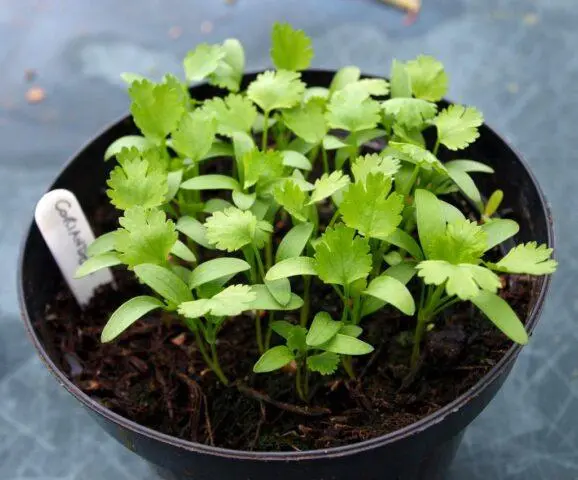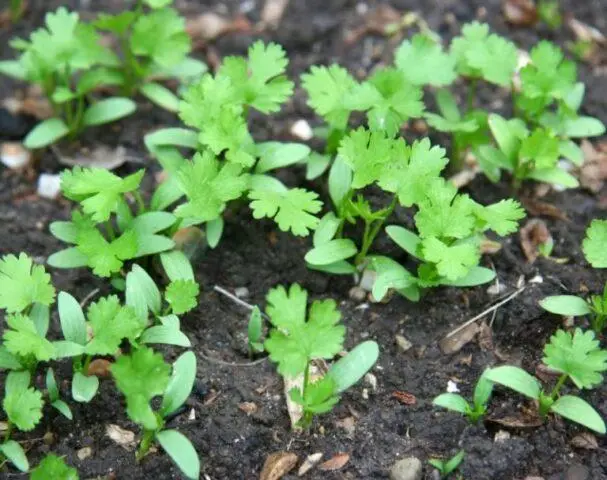Contents
Cilantro is one of those crops that even an inexperienced vegetable grower can handle growing. The plant is easy to plant and care for. However, before dealing with the cultivation of this crop, it is necessary to determine how quickly cilantro sprouts after sowing.
How many days do cilantro seeds germinate
Cilantro is distinguished by relatively short periods during which the first shoots appear. The process of crop growth depends on a host of factors, one of which is the preliminary state of the seeds.
As a rule, if the planting material has undergone preliminary preparation before planting, then the first shoots may appear within 5-20 days. If the seeds have not been processed, then the time for the appearance of sprouts can increase up to 20-30 days.
What do cilantro sprouts look like
It is quite difficult to distinguish coriander from other herbaceous crops in the early stages. As a rule, cilantro grows similar to most greens belonging to the Umbelliferae family. However, experts identify features according to which coriander can be determined externally. Cilantro emerges in the form of small loops, similar to the eye of a sewing needle. After 2-3 days, the sprout straightens and reaches 2-3 cm in length. At this stage, the shoots begin to form leaves that look like parsley.

Because of the structure similar to parsley, coriander received a second name – Chinese parsley.
A week after the shoots of the first sprouts, leaves appear in each of the young plants, shaped like blades with serrated edges. At this point in ripening, coriander becomes distinct from parsley and other herbs.
What determines the germination of cilantro (coriander) seeds
Under the germination of seeds, vegetable growers mean the number of shoots from the total number of planting material. Often, manufacturers calculate this criterion on their own and indicate it on the packaging. According to percentage statistics, the ideal germination rate is 90% of the total. However, in practice, the number of sprouts may be significantly less than stated.
As a rule, the following factors influence germination:
- seed quality;
- temperature and light conditions;
- the soil;
- hole depth;
- watering;
- processing before landing;
In order to increase the percentage of germination to the maximum possible, it is important to meet all the criteria that affect the growth of cilantro. The more factors that meet the requirements, the better the crop of the planted crop will be.
Quality of seeds
For most representatives of the Umbelliferae family, which include cilantro, the quality and freshness of the seeds are important criteria affecting germination. This feature is also inherent in parsley, dill, carrots and other crops. The fresher the seeds are, the more of them will sprout. In order to ensure the maximum percentage of germination, it is important to use planting material when sowing, which is no more than two years old.
Temperature and light conditions
It is known that most cultivated plants require compliance with temperature and light conditions. Cilantro in this case is no exception. For this culture, the optimum temperature is close to 25 ° C. The light period characteristic of coriander is within 10-12 hours.
If the basic requirements of the temperature and light regimes are not observed, or if there are significant deviations from them, the plants may not sprout within the desired period or die.
Depth of sowing
Excessive sowing depth can provoke late shoots of coriander or the death of the sprout as a whole. In order to avoid the consequences of improper planting, it is important to submerge the seeds at the optimum distance from the surface. As a rule, planting material is placed at a depth of 1,5 to 2 cm and sprinkled with soil.
soil
Cilantro is demanding on the selection of soil, but its composition does not imply the presence of complex mixtures. To create a favorable environment for the growth of coriander, it is necessary to take ordinary garden soil as a basis and add humus, peat and ash to it in equal proportions.

Thanks to the addition of humus and peat, the soil for planting cilantro is saturated with the nutrients necessary for rapid growth.
Processing before planting
Preparation of cilantro seeds is done four days before planting. In order for the coriander to rise as quickly as possible, it must first be rinsed under cold running water. They do this in order to wash away the essential oils contained in the seed coat, which can affect the growth rate.
What to do to make cilantro rise quickly
The rapid growth of cilantro is a merit of compliance with all the rules of agricultural technology for the plant. Speeding up the process of selecting seeds suitable for planting is quite simple. To do this, you need to place them in a saline solution for two hours. After time, empty or spoiled seeds will remain on the surface of the water, which will not sprout.
Seed preparation before planting
To speed up the process of emergence of sprouts, it is necessary to place the seeds for 1-2 hours in water before planting. The temperature of the liquid should be close to room temperature. We also allow the option of soaking the seeds for two days. In this case, the water in which the seed will lie must be changed every 12 hours.
This procedure is optional for the seeds of this crop, but it will speed up the ripening period of cilantro.
Proper landing technique
Initially, before planting, it is necessary to prepare the beds and furrows in which the seeds will be placed. The sowing depth of coriander should not exceed 2 cm, as this threatens to slow down the germination of the plant.
The distance between the grooves should be 40-50 cm, so that when the seeds germinate, each of them gets the necessary amount of light. An interval of 10 cm should be kept between the sowing material. Thus, the plant will have sufficient area for germination.
Creating a greenhouse effect
Creating a greenhouse effect is necessary if cilantro is grown at home, and not in open areas. To do this, the container with planted seeds must be covered with glass or cling film.
The microclimate created inside the container allows you to speed up the process of sprout germination and has a positive effect on the ripening time of the crop.
The use of growth stimulants
For quick germination, many vegetable growers resort to the use of growth stimulants. Chemical additives are used at the stage of seed soaking. The longer the seed lies in water with a stimulant, the greater the effect of the agent on the process of its growth.
In addition to the chemical version of the stimulant, it is also possible to use a natural supplement for accelerated growth. To do this, when soaking cilantro, replace the water with aloe juice.
What to do if the cilantro did not rise
The cultivation of cilantro takes place several times per season, so if you try to plant unsuccessfully, you should not despair. If the coriander seeds have not sprouted, then the planting material should be changed or the place of its landing should be changed.

The most favorable soil for the growth of cilantro is considered to be the soil after onions and garlic.
Conclusion
In order to know for sure how long after planting cilantro sprouts, it is necessary to take into account many factors. The growth process of this crop can be accelerated if you know the intricacies of care and cultivation.









